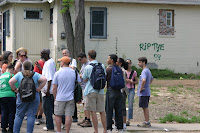
one of my ongoing regrets is that i do not take advantage of all this city has to offer. so today i decided to take a walking tour of barry farm that was given as a part of walkingtown dc. it was fascinating!
barry farm, probably best known as one of the notorious public housing projects in ward 8 east of the anacostia river, has a remarkable history as one of the first communities in the area where freed slaves could own property. the tract of land, once the farm of the barry family and immediately to the south of historic anacostia (interestingly, back in the day, historic anacostia was known as "white" anacostia and barry farm was known as "black" anacostia), once measured in the 100's of acres and extended from the banks of the anacostia river up into the hills. times have changed and what remains is land divided by two major highways (suitland parkway and 295) that can now be measured in the 10's of acres and where most of the residents, some of the poorest in the district of columbia, are dependent on the government for their housing. i came away with a few thoughts and a few pictures -
*one division of the land came with the construction of suitland parkway. land was taken from property owners to build a road that would link andrews airforce base to the district. something tells me that they wouldn't have tired this in georgetown.
barry farm with suitland parkway smack through the middle
*events like this are critical to foster understanding between groups of people and hopefully will create a sense of urgency on the part of the tour takers to stand with our fellow city dwellers to improve opportunities and outcomes for all of us.
*of course walkingtown dc includes tours of georgetown, capitol hill, logan circle and the like, but this event gives people the perfect opportunity to step out beyond what we know (or could easily find out) and learn more of the history that links us and, unfortunately, seems to divide us.




2 comments:
I'm glad you were able to take the tour--there is a lot to learn from Barry Farms. If I'm not mistaken, it was the first area of land purchased in DC specifically to try and meet the "mule and 40 acres" deal during the Civil War. I know it was purchased from David Barry in the late 1860's.
Bread for the City (non-prof I work for) is doing a lot of work in Barry Farms with the New Communities Initiative. It's nice to see someone else talking about it.
Barry Farm was sold to the Bureau of Refugees, Freedmen, and Abandoned Lands in 1867. The deal was done between the heirs of James Barry and Freedmen's Bureau Commissioner General O. O. Howard.
Visit it now as the current homes will be gone soon. The current housing was built during World War II.
It is nice to know that NCI is a least helping people before they displace them. Build First would be nice if it actually takes place.
Post a Comment